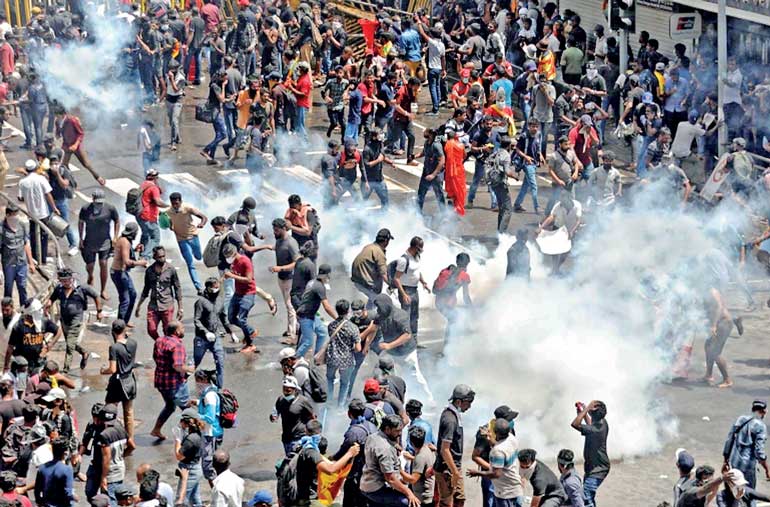Friday Dec 05, 2025
Friday Dec 05, 2025
Friday, 22 July 2022 00:12 - - {{hitsCtrl.values.hits}}

 For the past two years I have been advancing the notion that Sri Lanka has ended one era of its civilisation and was moving towards a new one, for better or for worse. It implies that the old system has become so irresistibly corrupt that it can no longer sustain itself; it also implies that a profound transformation of the socio-political system and economy is indispensable for the country to move forward. The two public insurrections in the past could be considered as instances where the birth pangs of an emergent new system struggling to be born have been demonstrated.
For the past two years I have been advancing the notion that Sri Lanka has ended one era of its civilisation and was moving towards a new one, for better or for worse. It implies that the old system has become so irresistibly corrupt that it can no longer sustain itself; it also implies that a profound transformation of the socio-political system and economy is indispensable for the country to move forward. The two public insurrections in the past could be considered as instances where the birth pangs of an emergent new system struggling to be born have been demonstrated.
Comparison with great revolutions
The uprising on 9 July can be considered as the biggest public uprising ever in Sri Lanka. An excellent article written by Nishantha Jayasuriyarachchi on it appeared in social media in which he maintains that it is a revolution which becomes no second to any one of the great revolutions that broke out in the world namely, the French Revolution of 1789, the Paris Commune of 1871 or the Great October Revolution of 1917. He has described it as a great struggle of non-violence. But the way I perceive it, is quite different from the way he sees it.
The great revolutions such as the English Revolution, the American Revolution and the French Revolution can be considered as momentous events that have bequeathed new and eternal values for the entire human race rather than limiting their outcomes to the countries where they have originated. The English Revolution of 1688 established the supremacy of the legislature in law-making. The Bill of Rights of 1689 has had its impact on it. Magna Carta, the Great Charter of Freedoms was issued in June 1215. It was the first document to put into writing the principle that the king and his government was not above the law.
The Magna Carta is often seen as the basis of liberty and justice as we know it today. In fact, it was as a result of the Magna Carta the world inherited the concept of the rule of law that maintains that ‘no free (English) man shall be seized or imprisoned, or stripped of his rights and possessions, or outlawed or exiled, or deprived of his standing in any other way except by the law of judgment by the law of the land. In 1776 the founding fathers of the United States of America looked to the Magna Carta as a historical precedent for asserting their liberty from the English crown. Consequently, the United States Declaration of Independence of 1776, which can be considered as an outcome of the American Revolution, can be considered as the origin of the concept of the international human rights law.
The French Declaration of the Rights of Man and of the Citizen of 1789, which can be considered as a legacy of the French Revolution, led to the further improvement and nourishment of the concept of human rights law. The Universal Declaration of Human Rights, a foundational text in the history of human and civil rights, adopted by the United Nations General Assembly in 1948, can be considered as the culmination of the United States Declaration of Independence of 1776 and the French Declaration of the Rights of Man and of the Citizen of 1789.
The Indian independence movement launched with the ultimate aim of ending British rule in India can be considered as the biggest nonviolent movement emerged in the world. It lasted from 1857 to 1947, and eventually led to the defeat of the world’s most powerful colonialist empire through a series of historic non-violent mass struggles. Despite public uprising that occurred on 9 July being very important for us in Sri Lanka, it is not advisable or prudent to compare it with the greatest revolutions in the world and treat it as the greatest of them.
Revolution of 9 July
Although not in the complete sense of the word, the public uprising of 9 July in Sri Lanka can be considered as a limited revolution. Nonetheless, it can certainly be considered as the biggest popular uprising to burst out in Sri Lanka so far. The impact it made on the diminution of the domination exerted by the Rajapaksa family on Sri Lankan politics and creation of a situation for President Gotabaya Rajapaksa to flee the country can be described as the most significant outcome of it. Apparently, sending Gotabaya home was the main objective of the youth uprising; but it is evident that some of the organisations that led the uprising had a hidden agenda to go beyond this objective and advance the struggle to seize political power.
As the rebels of the French Revolution had captured the Bastille, the fortress that protected the eastern part of France, the Sri Lankan strugglers also were able to storm and capture several places of symbolic importance namely the Presidential Residence, the Temple Trees and the Prime Minister’s Office. An unarmed powerful public uprising may have the ability to oust a government in power, but it cannot have the ability to seize power at the same time. If that is to be the case, it must be a revolution aimed at usurping political power.
If not, the seizure of power must take place through a parliamentary election. The lack of a clear and practical vision of this central issue, which is of great importance, can be considered as the biggest factor which has affected the survival and the progress of the struggle. The organisations involved in this mass uprising have not formed themselves into a well-knit cohesive movement with a clear common objective; and also it lacks strong alternative leaders in addition to the problem of not having a clear practical vision.
Some of the great characters of world history who are considered to be talented leaders have emerged in times of crisis. Oliver Cromwell (1599-1658) George Washington (1599-1651) Napoleon Bonaparte (1769-1821), V.I. Lenin (1870-1924) and Mahatma Gandhi (1869-1948) are examples that can be cited to prove that. These five leaders possessed incredible courage, self-confidence, the ability to make decisions in difficult situations and the skill to get the talented people to work for them. During this struggle in Sri Lanka, there was no space for alternative and talented leaders to emerge. Even in rare instances where such persons have surfaced, an evil system was in operation to crush them without allowing them to raise their heads and come forward.
Therefore, the strugglers of the uprising were compelled to fight against the corrupt leaders in power in the absence of alternate leaders of high calibre to propel the struggle. As already mentioned before, it can be said that the absence of a clear practical vision has been the biggest weakness of this struggle. If the power is to be gained, it must be achieved either through an election or an appropriate revolution. If they want a change in the system, they should appear for an appropriate reform program. Consequently they were able to oust President Gotabaya from his office, but unable to appoint an alternate president acceptable to them in his place.
Under the circumstances, they will be compelled to follow a similar policy in regard to the next President who will be elected by the Parliament.
The Aragalaya has a method to oust the rulers, but it has no methodology to appoint suitable new rulers. So much so, the strategy of ousting rulers may soon become a process that makes the people tired of it.
The public acceptance of the struggle does not remain strong at the moment. It remains at a low level. The internal conflicts among the strugglers are clearly visible to the public. It has weakened the public’s trust in them. Despite the fact that the people are tired of the conventional and old leaders, the Aragalaya has not been successful in producing a group of talented alternative leaders to replace them.
The strategy adopted by the Aragalaya has also caused criticism of the public.
The language used by the people of Aragalaya too, appears to have assumed a vulgar, uncivilised and lumpen tone which is rather unbecoming of the spirit of nonviolence. When a peaceful struggle ebbs into such a level, it has the tendency to become a destructive movement that causes strong public opposition against it.
However, in spite of the Aragalaya having a militant appearance, it would be possible to avoid it falling into such an unfortunate situation, and direct it into an effective path provided it is moved away from the current chaotic path and directed to a path that appears for powerful structural reforms that will lead to a profound change in the system which is corrupt and evil. It is only through such a reform program will it be possible to bring about a profound change in the current system which is corrupt and destructive and make it truly a major change.